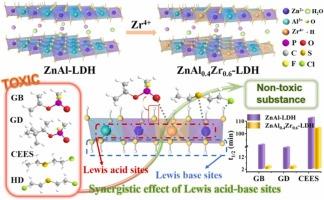掺杂 Zr4+ 的层状双氢氧化物中路易斯酸碱位点的协同效应促进了环境条件下神经毒剂和水疱毒剂的快速净化
IF 12.2
1区 环境科学与生态学
Q1 ENGINEERING, ENVIRONMENTAL
引用次数: 0
摘要
神经毒剂和水泡剂是对社会构成重大威胁的最致命化学物质之一,而开发可在无溶剂环境条件下快速净化神经毒剂和水泡剂的材料是一项重大的社会挑战。本文合成了不同 Zr4+ 掺杂含量的层状双氢氧化物(ZnAlxZr1-x-LDH),并研究了其在环境条件下对神经毒剂和水泡剂的去污性能。结果表明,与 ZnAl-LDH 相比,掺杂 Zr4+ 量最高的 ZnAl0.4Zr0.6-LDH 可使沙林(GB)和索曼(GD)的去污反应半衰期分别缩短 10 倍和 9 倍。机理研究表明,ZnAl0.4Zr0.6-LDH 利用路易斯酸碱位点的协同效应,将 GB 和 GD 催化分解为水解产物和表面结合型水解产物。研究还表明,在环境条件下,ZnAl0.4Zr0.6-LDH 对硫芥子气(HD)模拟物 2-氯乙基硫醚(CEES)的去污性能优于 ZnAl-LDH,能有效催化 CEES 解毒为脱氢卤化(EVS)和 1,2-双(乙硫基)乙烷(BETE)。ZnAl0.4Zr0.6-LDH 对 HD 的净化性能也令人满意。这项工作不仅提供了一种具有实际应用潜力的绿色高效催化剂,还为构建广谱、高效的自解毒材料提供了新的见解。本文章由计算机程序翻译,如有差异,请以英文原文为准。

Synergistic effect of Lewis acid-base sites in Zr4+-doped layered double hydroxides promotes rapid decontamination of nerve and blister agents under ambient conditions
Nerve and blister agents are among the deadliest chemicals posing a major threat to the society, and the development of materials that can rapidly decontaminate them under solvent-free ambient conditions is a major societal challenge. In this paper, layered double hydroxides (ZnAlxZr1-x-LDH) with varying Zr4+ doping content were synthesized and the decontamination properties of nerve and blister agents were investigated under ambient conditions. The results show that, compared to ZnAl-LDH, the ZnAl0.4Zr0.6-LDH with the highest amount of Zr4+ dopant reduced the decontamination reaction half-life of sarin (GB) and soman (GD) by 10 and 9 times, respectively. Mechanism studies revealed that ZnAl0.4Zr0.6-LDH employs the synergistic effect of Lewis acid-base sites to catalyze the decomposition of GB and GD into hydrolysis products and surface-bound hydrolysis products. The study also showed that under ambient conditions, ZnAl0.4Zr0.6-LDH demonstrated superior decontamination performance for the sulfur mustard (HD) simulant 2-chloroethyl ethyl sulfide (CEES) compared to ZnAl-LDH, effectively catalyzing the detoxification of CEES into dehydrohalogenation (EVS) and 1,2-bis-(ethylthio) ethane (BETE). ZnAl0.4Zr0.6-LDH also had satisfactory decontamination performance against HD. This work provides not only a green and efficient catalyst with potential for practical applications but also new insights for constructing broad-spectrum, highly efficient self-detoxifying materials.
求助全文
通过发布文献求助,成功后即可免费获取论文全文。
去求助
来源期刊

Journal of Hazardous Materials
工程技术-工程:环境
CiteScore
25.40
自引率
5.90%
发文量
3059
审稿时长
58 days
期刊介绍:
The Journal of Hazardous Materials serves as a global platform for promoting cutting-edge research in the field of Environmental Science and Engineering. Our publication features a wide range of articles, including full-length research papers, review articles, and perspectives, with the aim of enhancing our understanding of the dangers and risks associated with various materials concerning public health and the environment. It is important to note that the term "environmental contaminants" refers specifically to substances that pose hazardous effects through contamination, while excluding those that do not have such impacts on the environment or human health. Moreover, we emphasize the distinction between wastes and hazardous materials in order to provide further clarity on the scope of the journal. We have a keen interest in exploring specific compounds and microbial agents that have adverse effects on the environment.
 求助内容:
求助内容: 应助结果提醒方式:
应助结果提醒方式:


